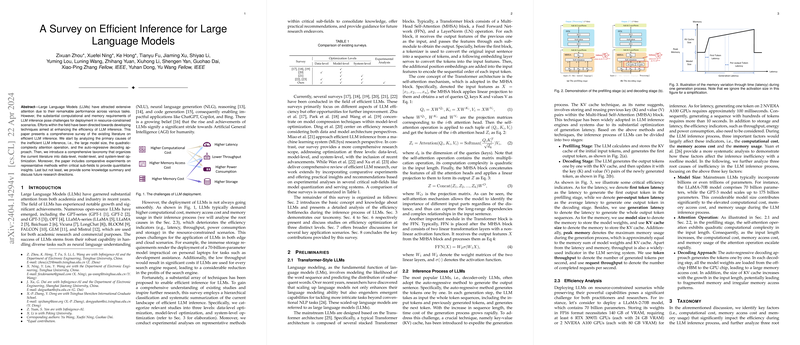Efficient Inference in LLMs: An Analytical Overview
The exponential rise in the capabilities and usage of LLMs has necessitated a rigorous focus on optimizing inferencing efficiencies. This paper explores a comprehensive survey aimed at unraveling various methodologies devised to enhance efficiency in LLM inference. In light of the increasing computational and memory demands that LLMs like GPT-3 and LLaMA present, the research methodically categorizes existing optimization techniques into three primary spheres: data-level, model-level, and system-level optimizations. Here, we provide an analytical overview of the paper, elucidating the key approaches and future research trajectories within this domain.
Data-Level Optimization
Data-level optimizations in LLM inference primarily target the efficient handling of input and output sequences, presenting techniques such as input compression and output organization. Input compression involves methods like prompt pruning and prompt summary, capable of dynamically reducing context length to minimize computational overhead. Techniques such as Retrieval-Augmented Generation (RAG) further diversify this approach by integrating external knowledge bases to streamline inputs effectively.
Output organization, encapsulated by methodologies like Skeleton-of-Thought (SoT) and its extensions, aims to parallelize generation processes. This is achieved by structuring output sequences into modular, independently computable units, enabling batch processing and reducing latency considerably.
Model-Level Optimization
Model-level optimizations encompass both the design of efficient LLM structures and the compression of pre-trained models. The paper delineates two major paths here: efficient structure design and model compression.
Efficient Structure Design
The push for efficient model architectures has given rise to innovations beyond the Transformer paradigm. Techniques like Mixture-of-Experts (MoE) in FFNs exploit modularity by dynamically selecting expert networks based on input characteristics, significantly reducing redundant computations without degrading performance. Similarly, the exploration into non-Transformer models (e.g., State Space Models) that leverage recurrence and convolution operations illustrates potential strides towards models with linear complexity in sequence length, beneficial for long-context processing.
Model Compression
Model compression techniques such as quantization, sparsification, and knowledge distillation play pivotal roles. Quantization, both through Post-Training Quantization (PTQ) and Quantization-Aware Training (QAT), strategically reduces precision in weights and activations to mitigate memory and computational demands. Methods like GPTQ and ZeroQuant exemplify the nuanced approaches to preserving model accuracy while achieving significant compression.
In parallel, sparsification methodologies, including weight pruning and sparse attention mechanisms, aim to eliminate redundant computations at neuron and token levels, respectively. Knowledge distillation focuses on transferring competencies from larger teacher models to smaller student models, preserving essential abilities like in-context learning and reasoning while reducing footprint.
System-Level Optimization
The system-level optimizations target the operational efficiency of inference engines and serving systems underpinning LLM deployments.
Inference Engine
Notable advancements here include speculative decoding, designed to accelerate token generation during decoding by employing secondary draft models and verifying outputs in parallel. This approach has demonstrated substantial reductions in latency.
Graph and operator-level optimizations are also pivotal. Fused kernel techniques and memory-efficient operator implementations like FlashAttention and FlashDecoding++ alleviate memory access bottlenecks and enhance computational throughput by merging lightweight operations and optimizing attention mechanisms.
Serving System
Serving system optimizations must address the asynchronous nature of LLM requests, encompassing fields such as memory management and effective batching and scheduling strategies. Techniques like continuous batching and paged KV cache management are instrumental here. Moreover, distributed systems extend these optimizations by strategically segregating prefilling and decoding tasks across computational nodes, thus maximizing resource utilization.
Comparative Insights and Future Directions
Efficiency Versus Emergent Capabilities
The juxtaposition of efficiency enhancements with retaining emergent LLM capabilities—such as long-range dependencies and contextual understanding—poses a nuanced challenge. Future studies must persist in seeking architectures that balance these twin needs proficiently.
Smaller Yet Potent Models
Pre-training smaller yet capable LLMs remains a fertile ground for research, promising reduced inference resource consumption without significant performance loss. Techniques in low-rank factorization, combined compression methodologies, and enhanced PEFT tuning strategies hold potential here.
Security Efficiency Trade-Offs
Ensuring that efficiency optimizations do not inadvertently compromise the security and robustness of LLMs is paramount. Exploration into secure-by-design optimization methodologies is a promising avenue.
Conclusion
This paper synthesizes a rich tapestry of research aimed at realizing efficient LLM inference. By providing systematized categorizations and analyses of data-, model-, and system-level optimizations, alongside empirical evaluations, it paves a path for future research endeavors. The insights derived from this survey will undoubtedly inform and inspire subsequent advancements targeted towards more efficient and versatile LLM deployments.
